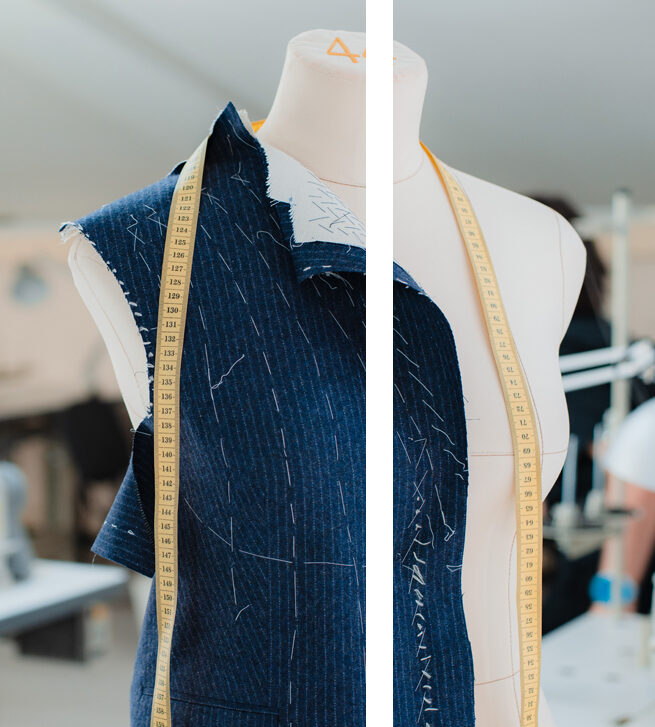Understanding the Tailoring Process: From Fabric Option to Final Fitting for the Perfect Closet
The customizing procedure is a complex interaction of art and scientific research, beginning with the important decision of material choice and culminating in the exact modifications of last installations. Each textile kind brings unique qualities that affect not only the visual allure however also the garment's long life and suitability for numerous events. Understanding the subtleties of tailoring methods can boost one's wardrobe to extraordinary degrees of sophistication. As we explore these elements even more, one need to take into consideration exactly how even the smallest details can substantially influence the total result of one's personal design.
Significance of Fabric Choice
Selecting the appropriate fabric is vital in the tailoring procedure, as it straight affects the comfort, longevity, and total aesthetic of the final garment (tailor perth). The choice of fabric sets the foundation for the garment's performance, design, and capability. Different fabrics possess unique residential or commercial properties, such as stretch, weight, and breathability, which can significantly impact how the garment drapes and fits the body
In addition, textile choice influences the garment's durability and ease of care. Premium fabrics can withstand deterioration, preserving their appearance and structure over time, while lower-quality materials might cause pilling or fading. Furthermore, the ideal material adds to the garment's capability to transition across events and seasons, thereby boosting versatility.
A tailored piece made from a proper textile not only showcases workmanship yet also raises the wearer's self-confidence. Comprehending the subtleties of fabric selection is vital for any type of tailoring undertaking. It makes certain that the end product not only fulfills the visual wishes of the client yet additionally aligns with useful demands, consequently achieving a harmonious equilibrium between kind and function in the tailored closet.
Kinds Of Fabrics and Their Usages
Recognizing the different sorts of fabrics available is crucial for making informed decisions during the tailoring procedure. Each fabric has one-of-a-kind features that determine its viability for specific garments and celebrations.
Cotton, known for its breathability and gentleness, is excellent for sportswear and summertime clothing. Its flexibility enables it to be customized right into every little thing from shirts to gowns. Woollen, on the various other hand, is favored for its heat and structure, making it a superb choice for formal fits and outerwear - tailor perth. Its all-natural elasticity helps garments keep shape gradually.
Silk exhibits deluxe and is lightweight, making it perfect for eveningwear and delicate shirts; however, it calls for mindful handling as a result of its delicacy. Linen, with its textured finish, is a prominent choice for cozy environments, providing a airy and crisp feeling, yet it wrinkles easily, which may impact the garment's appearance.
Synthetic textiles, such as polyester and nylon, offer resilience and resistance to creases, making them appropriate for daily wear and active apparel. Understanding these textile kinds and their homes allows for much better decision-making, making certain that each tailored piece not just fits well but additionally straightens with the designated objective and occasion.
The Tailoring Methods Clarified
The art of customizing depends on a range of methods that change textile right into well-fitted garments. see here Central to this process is pattern preparing, where a dressmaker produces themes based upon the customer's measurements and desired design. This first step ensures that the garment will certainly fit the user properly before any type of reducing takes place.
When patterns are developed, reducing techniques come into play. Precision is vital as errors can bring about misfitting garments. Tailors commonly use various reducing approaches, such as single-layer cutting for detailed styles and multiple-layer cutting for effectiveness on standard patterns.
Basting is an additional essential method, allowing tailors to briefly sew textile assemble for an initial installation. This approach supplies the opportunity to assess the drape and total silhouette prior to final sewing.
Seaming techniques, consisting of french seams and flat-felled joints, boost the garment's toughness and visual allure. Tailors also employ strategies such as interfacing and extra padding to supply framework and shape to specific locations, like collars and shoulders.
Last but not least, ending up strategies, including hemming and edge finishing, ensure the garment's long life while providing a polished look. With each other, these techniques form the backbone of reliable customizing, resulting in exquisite, tailor-made apparel.
Fitting Adjustments and Considerations

Secret considerations consist of the shoulder fit, which ought to neither droop neither limit motion, and the sleeve length, which ought to permit for comfy arm movement while preserving a refined look. Furthermore, changes at the midsection can refine the silhouette, with choices to allow out or absorb fabric as needed.
The surge of pants is an additional crucial element; it needs to sit comfortably over the hips without creating discomfort, permitting simplicity of activity. Hemming sizes for both pants and skirts need to mirror the user's favored design while appreciating percentages.

Preserving Your Tailored Wardrobe
Constantly adhere to the care tag instructions, which might recommend dry cleaning for delicate materials or machine cleaning for even more long lasting materials. Avoid frequent laundering, as this can use down the fabric and modify the garment's form.
Storage space is similarly essential; use cushioned wall mounts for coats and coats to keep shoulder framework, and store trousers folded nicely or hung to stop creasing. Safeguard garments from straight sunlight, which can fade shades and damages fibers.
Additionally, routine inspections for minor repair work can protect against bigger problems. Check for loose buttons, fraying joints, or signs of moth damage, attending read here to these issues promptly to maintain the garment's integrity.
Lastly, consider seasonal rotation. Wearing customized items in small amounts allows fabrics to recover, expanding their life-span. By executing these upkeep techniques, you can guarantee that your tailored garments stay as pristine as the day you initially wore them, improving your optimal wardrobe for many years to find.
Conclusion
The customizing procedure, including textile selection, proficient strategies, and accurate suitable changes, plays a vital function in developing garments that improve both comfort and style. Each phase contributes to the total efficiency of the end product, making certain that clothing not only fits well yet likewise reflects private identity. Additionally, recognizing the value of upkeep extends the life of customized garments, solidifying their worth in a well-curated wardrobe. An extensive technique to tailoring finishes in a sleek and positive look.
Selecting the right material is essential in the customizing process, as it directly affects the comfort, longevity, and total visual of the final garment. The option of textile establishes the structure for the garment's performance, design, and efficiency. Various materials possess unique residential or commercial properties, such as weight, stretch, and breathability, which can substantially affect exactly how the garment drapes and fits the body.
The art of customizing depends on a selection of methods that change fabric right into well-fitted garments.The customizing process, including textile selection, proficient techniques, and specific suitable changes, plays a critical role in producing garments that improve both convenience and design.